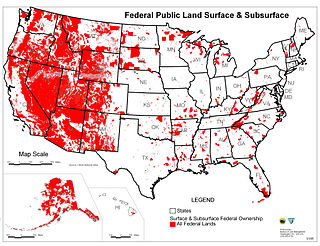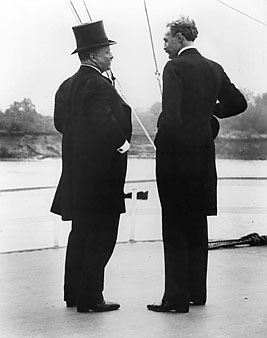Related Research Articles

The Tenth Amendment to the United States Constitution, a part of the Bill of Rights, was ratified on December 15, 1791. It expresses the principle of federalism, also known as states' rights, by stating that the federal government has only those powers delegated to it by the Constitution, and that all other powers not forbidden to the states by the Constitution are reserved to each state.

The National Park Service (NPS) is an agency of the United States federal government within the U.S. Department of the Interior that manages all national parks, most national monuments, and other natural, historical, and recreational properties with various title designations. The U.S. Congress created the agency on August 25, 1916, through the National Park Service Organic Act. It is headquartered in Washington, D.C., within the main headquarters of the Department of the Interior.

The federal government of the United States is the national government of the United States, a federal republic located primarily in North America, composed of 50 states, five major self-governing territories, several island possessions, and the federal district and national capital of Washington, D.C., where most of the federal government is based.

In the United States, a national monument is a protected area that can be created from any land owned or controlled by the federal government by proclamation of the President of the United States or an act of Congress. National monuments protect a wide variety of natural and historic resources, including sites of geologic, marine, archaeological, and cultural importance. In contrast, national parks in the U.S. must be created by Congressional legislation. Some national monuments were first created by presidential action and later designated as national parks by congressional approval.
In the United States, a territory is any extent of region under the sovereign jurisdiction of the federal government of the United States, including all waters. The United States asserts sovereign rights for exploring, exploiting, conserving, and managing its territory. This extent of territory is all the area belonging to, and under the dominion of, the United States federal government for administrative and other purposes. The United States total territory includes a subset of political divisions.

The Clean Water Act (CWA) is the primary federal law in the United States governing water pollution. Its objective is to restore and maintain the chemical, physical, and biological integrity of the nation's waters; recognizing the responsibilities of the states in addressing pollution and providing assistance to states to do so, including funding for publicly owned treatment works for the improvement of wastewater treatment; and maintaining the integrity of wetlands.

A national recreation area (NRA) is a protected area in the United States established by an Act of Congress to preserve enhanced recreational opportunities in places with significant natural and scenic resources. There are 40 NRAs, which emphasize a variety of activities for visitors, including hiking, camping, boating, fishing, swimming, biking, horseback riding, and wildlife viewing, in areas that include multiple-use management for both conservation and limited utilization of natural resources. They have diverse features and contexts, being established around reservoirs, in urban areas, and within forests. Due to their size, diversity of activities, and proximity to population centers, NRAs are among the most visited units of the National Park System, with six among the thirty most visited sites.

Federal lands are lands in the United States owned by the federal government. Pursuant to the Property Clause of the United States Constitution, Congress has the power to retain, buy, sell, and regulate federal lands, such as by limiting cattle grazing on them. These powers have been recognized in a long line of United States Supreme Court decisions.

The National Wilderness Preservation System (NWPS) of the United States protects federally managed wilderness areas designated for preservation in their natural condition. Activity on formally designated wilderness areas is coordinated by the National Wilderness Preservation System. Wilderness areas are managed by four federal land management agencies: the National Park Service, the U.S. Forest Service, the U.S. Fish and Wildlife Service, and the Bureau of Land Management.

The United States Postal Regulatory Commission, formerly called the Postal Rate Commission, is an independent regulatory agency created by the Postal Reorganization Act of 1970. Like the Postal Service, it was defined in law as an independent establishment of the executive branch.

The National Wildlife Refuge System in the United States has a long and distinguished history.
The Fish and Wildlife Coordination Act (FWCA) of the United States was enacted March 10, 1934 to protect fish and wildlife when federal actions result in the control or modification of a natural stream or body of water. The Act provides the basic authority for the involvement of the United States Fish and Wildlife Service (Service) in evaluating impacts to fish and wildlife from proposed water resource development projects.
The Historic Preservation Fund (HPF) provides financial support for historic preservation projects throughout the United States. The fund is administered by the National Park Service (NPS), pursuant to the National Historic Preservation Act of 1966 (NHPA). The fund provides state historic preservation agencies with matching funds to implement the act.

Since 1872 the United States National Park System has grown from a single, public reservation called Yellowstone National Park to include 430 natural, historical, recreational, and cultural areas throughout the United States, its territories, and island possessions. These areas include National Parks, National Monuments, National Memorials, National Military Parks, National Historic Sites, National Parkways, National Recreation Areas, National Seashores, National Scenic Riverways, and National Scenic Trails.
The Redwood Act is a 1978 amendment to the US National Park Service General Authorities Act of 1970. The amendment is particularly notable for clarifying and supplementing the 1970 act and the National Park Service Organic Act of 1916 with the following two important sentences as the second and third to the General Authorities Act:
Congress declares that the national park system, which began with establishment of Yellowstone National Park in 1872, has since grown to include superlative natural, historic, and recreation areas in every major region of the United States, its territories and island possessions; that these areas, though distinct in character, are united through their inter-related purposes and resources into one national park system as cumulative expressions of a single national heritage; that, individually and collectively, these areas derive increased national dignity and recognition of their superlative environmental quality through their inclusion jointly with each other in one national park system preserved and managed for the benefit and inspiration of all the people of the United States; and that it is the purpose of this Act to include all such areas in the System and to clarify the authorities applicable to the system. Congress further reaffirms, declares, and directs that the promotion and regulation of the various areas of the National Park System, as defined in section 1c of this title, shall be consistent with and founded in the purpose established by section 1 of this title [the Organic Act provision quoted above], to the common benefit of all the people of the United States. The authorization of activities shall be construed and the protection, management, and administration of these areas shall be conducted in light of the high public value and integrity of the National Park System and shall not be exercised in derogation of the values and purposes for which these various areas have been established, except as may have been or shall be directly and specifically provided by Congress.

Starting in 1876, and undergoing a series of name changes, the U.S. Forest Service grew to protect and use millions of acres of forest on public land. Gifford Pinchot, an early advocate of scientific forestry, along with President Theodore Roosevelt and conservation organizations, led the effort to manage forest for the public good.

Public Law 113-2, containing Division A: Disaster Relief Appropriations Act, 2013 and Division B: Sandy Recovery Improvement Act of 2013 is a U.S. appropriations bill authorizing $60 billion for disaster relief agencies. The Budget Control Act of 2011 (BCA), had authorized only disaster spending and emergency spending to exceed established spending caps. While emergency spending is not subject to the caps in the BCA, spending for disaster relief is calculated by taking the average of the previous ten years disaster relief spending, excluding the highest and lowest spending years.

The Pandemic and All-Hazards Preparedness Reauthorization Act of 2013 is a law enacted by the 113th United States Congress. The Act amends the Public Health Service Act in order to extend, fund, and improve several programs designed to prepare the United States and health professionals in the event of a pandemic, epidemic, or biological, chemical, radiological, or nuclear accident or attack. The Act clarifies the authority of different American officials, makes it easier to temporarily reassign personnel to respond to emergency situations, and alters the process for testing and producing medical countermeasures. The Act is focused on improving preparedness for any public health emergency.
The October 2013 mini-continuing resolutions were a set of continuing resolutions that would have provided funding for a limited set of federal agencies during the United States federal government shutdown of 2013. The bills were part of a Republican strategy to fund portions of the government which have bipartisan support, in order to spare those agencies and programs from the effects of the shutdown. The bills all passed the United States House of Representatives during the 113th United States Congress, but were ignored by the United States Senate. These selective continuing resolutions became moot upon the passage of the Continuing Appropriations Act, 2014 which funded the entire government, ending the shutdown.
References
- ↑ An Act to improve the administration of the national park system by the Secretary of the Interior, and to clarify the authorities applicable to the system, and for other purposes. Pub. L. 91–383 , H.R. 14114, 84 Stat. 825 , enacted August 18, 1970.
- ↑ 16 U.S.C. § 1a-1, National Park System: administration; declaration of findings and purpose.